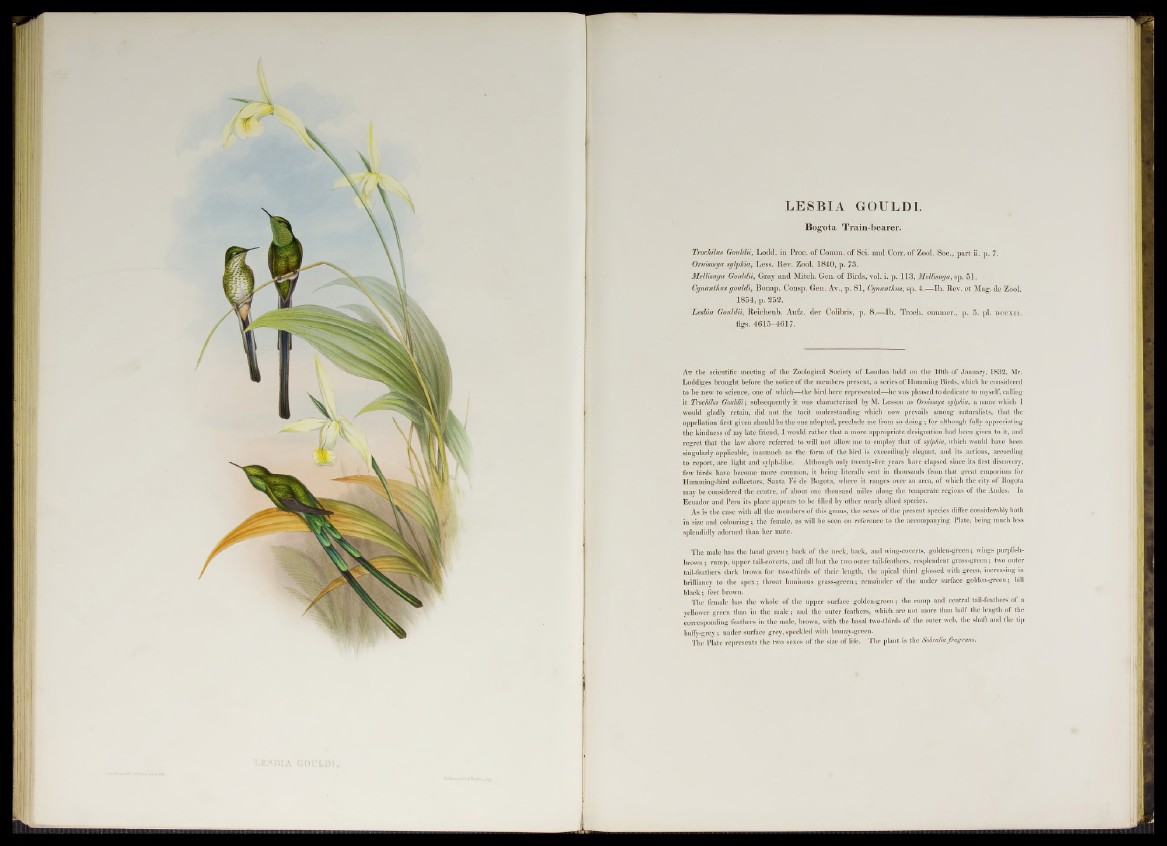
LESBIA GOULDI.
Bogota Train-bearer.
Trochilus Gouldii, Lodd. in Proc. o f Comm, o f Sci. and Corr. o f Zool. Soc., part ii. p. 7.
Omismya sylphia, Less. Rev. Zool. 1840, p. 73.
Mellimga Gouldii, Gray and Mitch. Gen. o f Birds, vol. i. p. 113, Mellisuga, sp. 51.
Cynanthus gouldi, Bonap. Consp. Gen. Av., p. 81, Cynanthus, sp. 4.—lb . Rev. et Mag. de Zool.
1854, p. 252.
Lesbia Gouldii, Reichenb. Aufz. der Colibris, p . 8 .—lb . Troch. enumer., p . 5. p i . d c c x i i .
figs. 4615—4617.
At the scientific meeting of the Zoological Society of London held on the 10th of January, 1832, Mr.
Loddiges brought before the notice of the members present, a series of Humming Birds, which he considered
to be new to science, one of which—the bird here represented—he was pleased to dedicate to myself, calling
it Trochilus Gouldii; subsequently it was characterized by M. Lesson as Omismya sylphia, a name which I
would gladly retain, did not the tacit understanding which now prevails among naturalists, that the
appellation first given should be the one adopted, preclude me from so doing; for although fully appreciating
the kindness of my late friend, I would rather that a more appropriate designation had been given to it, and
regret that the law above referred to will not allow me to employ that of sylphia, which would have been
singularly applicable, inasmuch as the form of the bird is exceedingly elegant, and its actions, according
to report, are light and sylph-like. Although only twenty-five years have elapsed since its first discovery,
few birds have become more common, it being literally sent in thousands from that great emporium for
Humming-bird collectors, Santa Fe de Bogota, where it ranges over an area, of which the city of Bogota
may be considered the centre, of about one thousand miles along the temperate regions of the Andes. In
Ecuador and Peru its place appears to be filled by other nearly allied species.
As is the case with all the members of this genus, the sexes of the present species differ considerably both
in size and colouring; the female, as will be seen on reference to the accompanying Plate, being much less
splendidly adorned than her mate.
The male has the head green; back of the neck, back, and wing-coverts, golden-green; wings purplish-
brown ; rump, upper tail-coverts, and all but the two outer tail-feathers, resplendent grass-green; two outer
tail-feathers dark brown for two-thirds of their length, the apical third glossed with green, increasing in
brilliancy to the apex; throat luminous grass-green; remainder of the under surface golden-green; bill
black; feet brown.
The female has the whole of the upper surface golden-green; the rump and central tail-feathers of a
yellower green than in the male; and the outer feathers, which are not more than half the length of the
corresponding feathers in the male, brown, with the basal two-thirds of the outer web, the shaft and the tip
buffy-grey ; under surface grey, speckled with bronzy-green.
The Plate represents the two sexes of the size of life. The plant is the Sobralia fragrans.